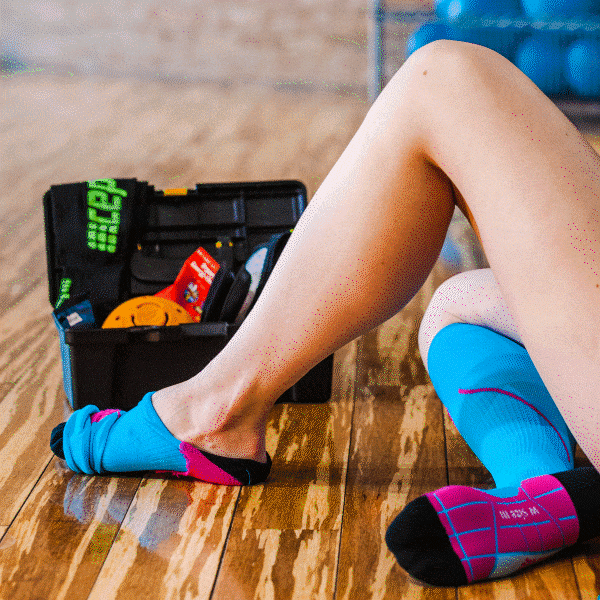Compression Socks and Sleeves: when to wear them, how they work, and why you should be wearing them
How does compression work?
Compression works by manipulating your arteries and veins to increase your circulatory efficiency.
Compression is measured in millimeters of mercury (mmHg). This is the amount of pressure that the sock can exert on your leg. In order for a compression sock to be effective it must have a minimum of 20mmHg at the ankle. They (veins and arteries) both respond positively to compression but in completely different ways.
Arteries are like PVC pipes, large smooth tubes that transport oxygen and nutrient rich blood to the body. Arteries have an inner and outer wall. The inner wall will contract and dilate when it senses external pressure. This maintains the arteries diameter to ensure consistent blood flow. This dilatation allows for them to transport more blood volume when the correct amount of compression is applied.
Veins are the other half of the equation; they bring de-oxygenated blood back up to the heart. Valves in your veins are like little one-way doors. They open and close to prevent reflux (flowing back) of blood. Compression decreases the diameter of the vein and increases the effectiveness of the valves and increases velocity of blood back to the heart.
What are the benefits of using compression products?
The increase in circulatory efficiency is what drives all of the benefits you see from compression. This newfound increase in blood flow is responsible for:
- Increasing the oxygenated blood that feeds your muscles during exercise.
- Blood is what filters lactic acid out of the muscles and returns it for filtration. The increased blood volume has the ability to remove more lactic acid.
- Lactic acid is produced when your muscles consume all the available oxygen in your blood; the increase in oxygenated blood reduces the amount of lactic acid produced during exercise.
But the benefits don't end there. Compression also helps to reduce vibration and muscle oscillation that can lead to fatigue and injury.
When is the best time to wear compression products?
The most beneficial times to wear compression are during running, for recovery, and while traveling.
During: Compression socks and sleeves bring oxygen rich blood filled with nutrients and hydration to the muscles. It also reduces vibration, which can improve muscle efficiency and mechanics. In addition you’ll flush out lactic acid and improve circulation to your calves while promoting healing. The increased circulation helps to increase blood flow to alleviate pain from common conditions such as calf & achilles strains, calf cramps, and shin splints.
Recovery: Compression socks can also be worn after activity as part of the recovery process from a run to decrease swelling and soreness in the foot, ankle, and lower leg. Lactic acid forms when the body breaks down carbohydrates to use for energy during times of low oxygen levels. Your body's oxygen level might drop during intense exercise. Medical grade compression penetrates the deep veins and helps flush out lactic acid in the veins and muscles – re-circulating it back to the heart. This will ensure it does not sit in your muscles overnight, helping you to recover more quickly.
Travel: One of the most important things an endurance athlete can learn is to wear graduated compression during travel. A DVT can be deadly when part of a blood clot breaks away and gets to the lungs or brain.
About 85% of air travel thrombosis victims are athletic, usually endurance-type athletes like marathoners. People with slower resting blood flow are at greater risk of stasis, stagnant blood subject to clotting. Also, they are more likely to have bruises and sore muscles that can trigger clotting.
What are the benefits to wearing a full sock vs. just a sleeve?
If you are going to be using the product exclusively for recovery, we recommend going with a sock. The sock will apply graduated pressure to the foot and ankle to pump blood back towards the heart. Using a sleeve may cause pooling of the blood around the ankle and foot. A sock is also good for travel to reduce the likelihood of blood clots in the calf. During activity, either a sock or sleeve can be used.
How do I know if something is "real" compression?
Compression in the medical channel is highly regulated by the FDA to ensure it meets very strict guidelines. In the athletic space, there are no regulations and the word compression can be used on any product regardless of if it actually offers any benefits of true compression.
Some tips for making sure the product you are buying is true compression:
- Make sure the compression product being worn is “Graduated Compression” – this means it’s tighter at the ankle (lowest point) and decreases as it comes closer to the heart. Most brands that are producing true compression will site their compression level on the package.
- The compression must be at least 20mmHg in the ankle to actually penetrate the deep veins and provide maximum benefit.
- Taking a circumference measurement of the leg is essential to get the correct compression – shoe size isn’t important, and if this is the only measurement they ask for it will not be properly sized.
- True compression has a complex manufacturing process, you get what you pay for - $40 for sleeves and $60 dollars for socks should be what you should expect to pay.
These socks are pretty tight, how can I get them on easier?
*article from Fleet Feet Chicago

Connect With Us
See the latest from Fleet Feet Springfield